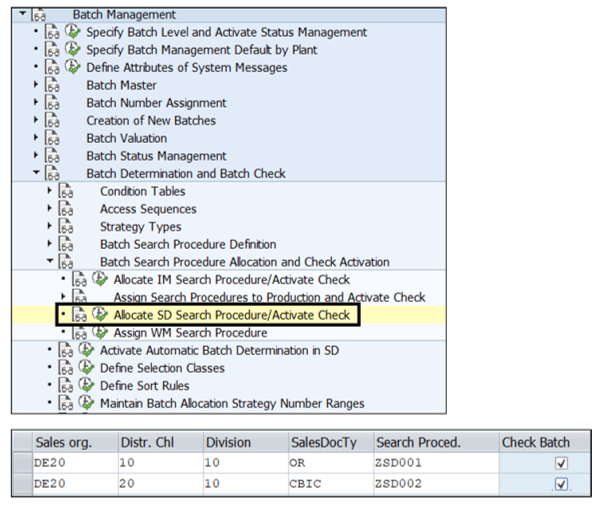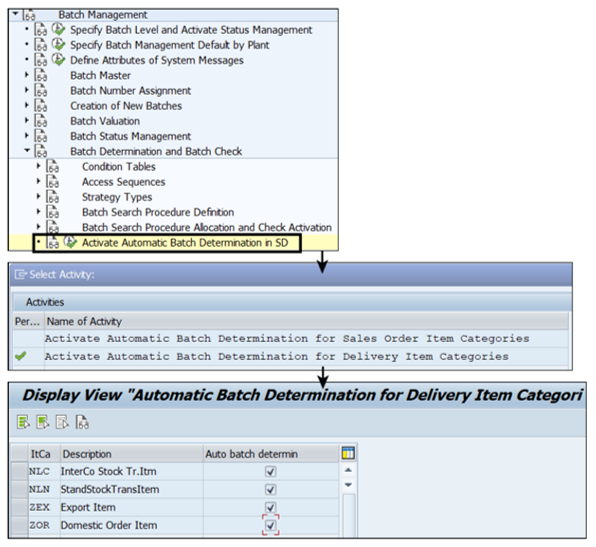Batch determination is a key feature in batch management that allows automatic determination or identification of a batch of materials during a business transaction.
For instance, batch determination can be used to automatically recommend the batch of finished items that must be delivered to a client or the raw materials that must be used during production. Batch management is a common practice among manufacturing and distribution companies.
In SAP S/4HANA, automatic batch determination is used in inventory management, production, sales and distribution, and WM to select batches and allocate them in a manufacturing order, an outbound delivery, or a goods issue/good receipt/goods transfer in inventory management.
Configuration for batch determination is very similar to the pricing procedure in purchasing. To configure the batch determination process, the following sequence of configuration steps need to be completed:
- Create condition tables.
- Maintain the batch determination access sequence.
- Define the appropriate batch strategy type (such as production, sales and distribution, warehouse management, etc.).
- Maintain the batch search procedure.
- Allocate the batch search procedure to organizational entities (such as the sales area or warehouse number) and activate the batch search procedure.
We’ll walk through each of these processes in further detail in the following sections.
Prerequisites for SAP Batch Determination: The prerequisites for batch determination are as follows:
- Batch level needs to be setup in configuration.
- Materials must be batch-managed.
- Material must be created with the classification view in the material master.
Condition Table
Condition tables are combinations of fields that form the key to the batch search strategy. These fields determine how the batches are searched in the system. There are preconfigured condition tables in SAP S/4HANA. SAP reserves number range 000 to 500, and the following number areas are reserved for condition tables in the standard system:
- 00–09 Sales and Distribution
- 10–19 Warehouse Management
- 20–29 Inventory Management
- 30–39 Production/Manufacturing
For custom creation of condition tables, number range 501 onward can be used.
The condition table can be created using menu path SPRO > SAP Reference IMG > Logistics - General > Batch Management > Batch Determination and Batch Check > Condition Table. Alternatively, you can use transaction codes to create condition tables in individual process areas such as Transaction OMA1 (for inventory management), Transaction OPLB (for process and production orders), Transaction V/C7 (for sales and distribution), and Transaction OMK4 (for WM).
The figure below shows a custom condition table configured in the sales and distribution process area.
4

Batch Determination Access Sequence
The batch determination access sequence is associated with the batch search strategy. The primary purpose of the access sequence is to enable sequential access to the condition tables by the strategy type. The strategy type with access sequence is automatic in nature. Users can’t manually enter or edit the rate or value. Users can manually edit the rate or value for those without an access sequence.
SAP S/4HANA provides a number of access sequences by default. If necessary, you can use these or create a new custom access sequence. The condition table chosen in the previous stage has to be entered in the access sequence in the proper sequence. The access sequence may contain one or more condition tables.
Configuration for access sequence follows menu path SPRO > SAP Reference IMG > Logistics - General > Batch Management > Batch Determination and Batch Check > Access Sequences. Alternatively, you can use transaction codes to maintain the access sequence in individual process areas such as Transaction OMCX (for inventory management), Transaction OPLF (for process and production orders), Transaction V/C2 (for sales and distribution), and Transaction OMKU (for WM).
The next figure represents a typical configuration in sales and distribution starting from the access sequence that encapsulates sequential access of condition tables:
1: Access Sequence
2: Two “accesses” beneath Access Sequence
3: Condition Table Number
4: Int indicator to consider NULL value in document of condition records
These condition tables are collections of fields that fetch the field values or rates from the corresponding SAP transaction.

Strategy Types
Strategy type determines the type of conditions and criteria applied during the batch determination process. The selection criteria and the sort rules used in batch determination procedures are stored in the configuration of the strategy type. Selection criteria or the search class are used to search for batches according to their characteristic values.
Strategy types are used ultimately to create the batch search master data or batch search condition record so that the system knows the exact level at which the search for batches is to be carried out along with the selection/sort rules of these batches. The search class isn’t assigned to the material but is a separate batch class that needs to be created and assigned to the material. This batch class will have the characteristics, and when the batch is created, those characteristic values will be populated.
The selection class (Transaction BMC1/BMC2/BMC3) is used to help the system choose a certain batch based on the characteristics and their fixed values. Sort rules (Transactions CU70/CU71/CU72) are used to help the system sort the batches for the given class characteristics.
The next figure, shows the assignment of the selection class (1) and sort rule for the batch search strategy (2). In the sort rule (3), selecting the Ascending checkbox for characteristics represents first expiry first out (FEFO), whereas selecting Descending represents the last in first out (LIFO) option.

The configuration menu path for maintaining batch search strategy types is SPRO > SAP Reference IMG > Logistics - General > Batch Management > Batch Determination and Batch Check > Strategy Types. Alternatively, you can use transaction codes to maintain strategy types: Transaction OMCW (for inventory management), Transaction OPLE (for process and production orders), Transaction V/C1 (for sales and distribution), and Transaction OMKT (for WM).
The next figure represents the configuration of the batch determination strategy in sales and distribution.

You then assign the selection class to the strategy and use the same in the condition record master data. In the condition records, you need to enter the required fixed values against any class characteristics that you want to use to search the batches.
Batch Search Procedure
A batch search procedure can have one or multiple search strategy types assigned in sequential priority. The batch search procedure thus becomes the final configuration that holds the total search configuration together. The following figure represents the configuration for the batch search procedure for sales and distribution.

The configuration menu path for maintaining batch search procedures is SPRO > SAP Reference IMG > Logistics - General > Batch Management > Batch Determination and Batch Check > Batch Search Procedure Definition. Alternatively, you can use transaction codes to maintain batch search procedures: Transaction OMCY (for inventory management), Transaction OPLG (for process and production orders), Transaction V/C3 (for sales and distribution), and Transaction OMKV (for WM).
Batch Search Procedure Allocation and Check Activation
Finally, the batch search procedure is allocated to different fields per process area. In inventory management, the batch search procedures are assigned to the movement types. In production or process orders, the batch search procedures are assigned to the production plants and order types. In sales and distribution, the batch search procedures are assigned to the sales areas and sales document types. In WM, the batch search procedures are assigned to the warehouse number and they can be also assigned to the warehouse number + movement type combination.
The configuration menu path for maintaining batch search procedure allocations is SPRO > SAP Reference IMG > Logistics - General > Batch Management > Batch Determination and Batch Check > Batch Search Procedure Allocation and Check Activation. Alternatively, you can use transaction codes to maintain batch search procedure allocations: Transaction OMCG (for inventory management), Transaction OPL8 (for process and production orders), Transaction V/C5 (for sales and distribution), and Transaction OMK1 (for WM).
This figure represents the assignment in the sales and distribution process area.

Activate Automatic Batch Determination in SD
In this step, automatic batch determination for order or delivery item categories can be activated. When entering an order item or a delivery item, batch determination is triggered automatically.
Configuration menu path for maintaining Batch Search Strategy is SPRO > SAP Reference IMG > Logistics - General > Batch Management > Batch Determination and Batch Check > Activate Automatic Batch Determination in SD (Transaction V/CA), as shown in the final figure.

Editor’s note: This post has been adapted from a section of the book Integrating Third-Party Logistics with SAP S/4HANA by Gautam Bhattacharya and Mehfuze Ali Molla. Gautam is a senior managing consultant at IBM, where he focuses on strategic sourcing and procurement, intercompany supply chain management and accounting, and 3PL integration. Mehfuze is a senior consultant at IBM. He has more than 15 years of SAP-related experience with ABAP and Basis, covering all project stages including requirements determination, gap analysis, business process reengineering, issue resolution, configuration, custom code specifications, testing, training, go-live assistance, and post implementation support.
This post was originally published 5/2024.



Comments